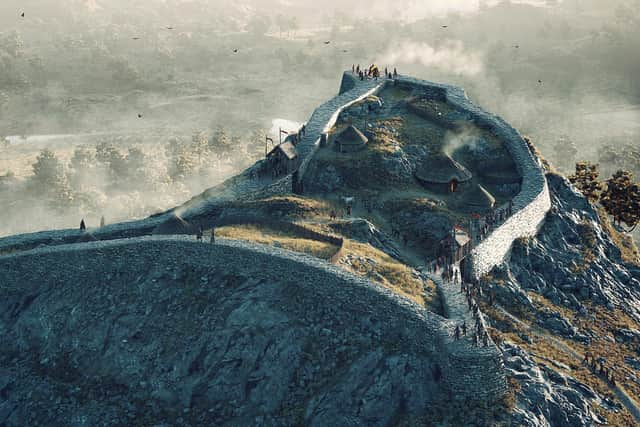Step back in time and tour an 'enigmatic' Pictish fort in the Highlands
Described as “unusually massive”, the hillfort has been dramatically rebuilt in augmented reality by historical reconstruction and illustrator Bob Marshall, who has worked with Forestry and Land Scotland to reimagine the ‘enigmatic’ site.
Dun da Lamh has never been excavated with only the lichen-covered stone ramparts – which measured between four and six metres – giving a clue to life at this once-mighty place.


Advertisement
Hide AdAdvertisement
Hide AdWhat happened here – and who called it home – has never been established but the new reconstruction places in the mind’s eye how Dun da Lamh may have appeared during its height.
Matt Ritchie, archaeologist with Forestry Land Scotland, said: “Little is known about what happened has never been excavated and remains an enigma. There is no visible unusual vitrification to explain and no historic event associated with the fort.
“Imagination plays a crucial role in our interpretation, and this time the archaeological narrative comes to the fore. For Dun da Lamh really is a very Highland hillfort – it boasts a
stunning location, incredible stone ramparts and an almost embarrassing dearth of previous archaeological investigation.
“The story of Dun da Lamh is almost completely unknown, and can be told only through the surviving remains and comparison with similar sites in the Highlands.”
Its name translates as ‘fort of the two hands’ which may relate to the two summits on which it stands.
The reconstruction has used information gathered by drone in a photogrammetric survey, which criss-crosssed the site to take hundreds of photographs from every angle.
Information known about other smaller Pictish-era citadels hillforts, such as Craig Phadrig, Tor Dhuin, Dun da Lamh and Dun Deardai was also taken into account.
Advertisement
Hide AdAdvertisement
Hide AdThe term ‘Pict’ is a generic term for the peoples of Scotland north of the Forth living in the first millennium AD.
The Picts, who lived north of the Forth in the first millennium AD, were the last major ethnic identity to become extinct in Britain with few clues left behind to help unravel the story of these mysterious people.
They emerged during the time of Roman rule of Britain with society run by an aristocratic ruling elite with their language, culture and identity disappearing after 500 years.
Mr Marshall completed the augmented reality piece for The Badenoch Great Place project, which aims to illuminate the heritage and landscape of this corner of the north.
He said: “Was this fort simply a final place of refuge, a place to keep out of harm's way from predatory animals perhaps, or was it a place of ceremonial and ritual gathering in addition to its martial purpose? My reconstruction no doubt generates more questions than it provides answers, but I hope that this work stimulates further discussion and interest at least.
It and other augmented reality images and stories – as well as driving, cycling and walking routes - will feature on the Badenoch – Badenoch the Storylands app which has been designed to guide visitors and locals through the rich detail of the area.